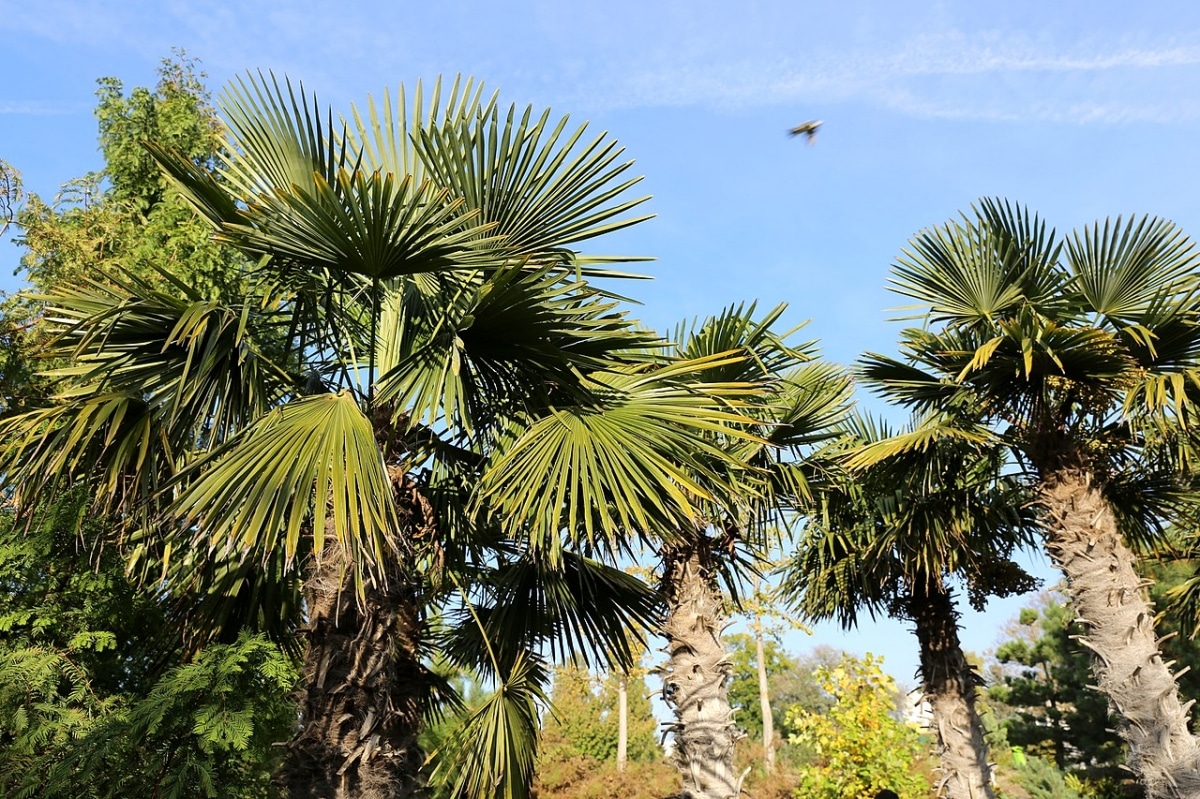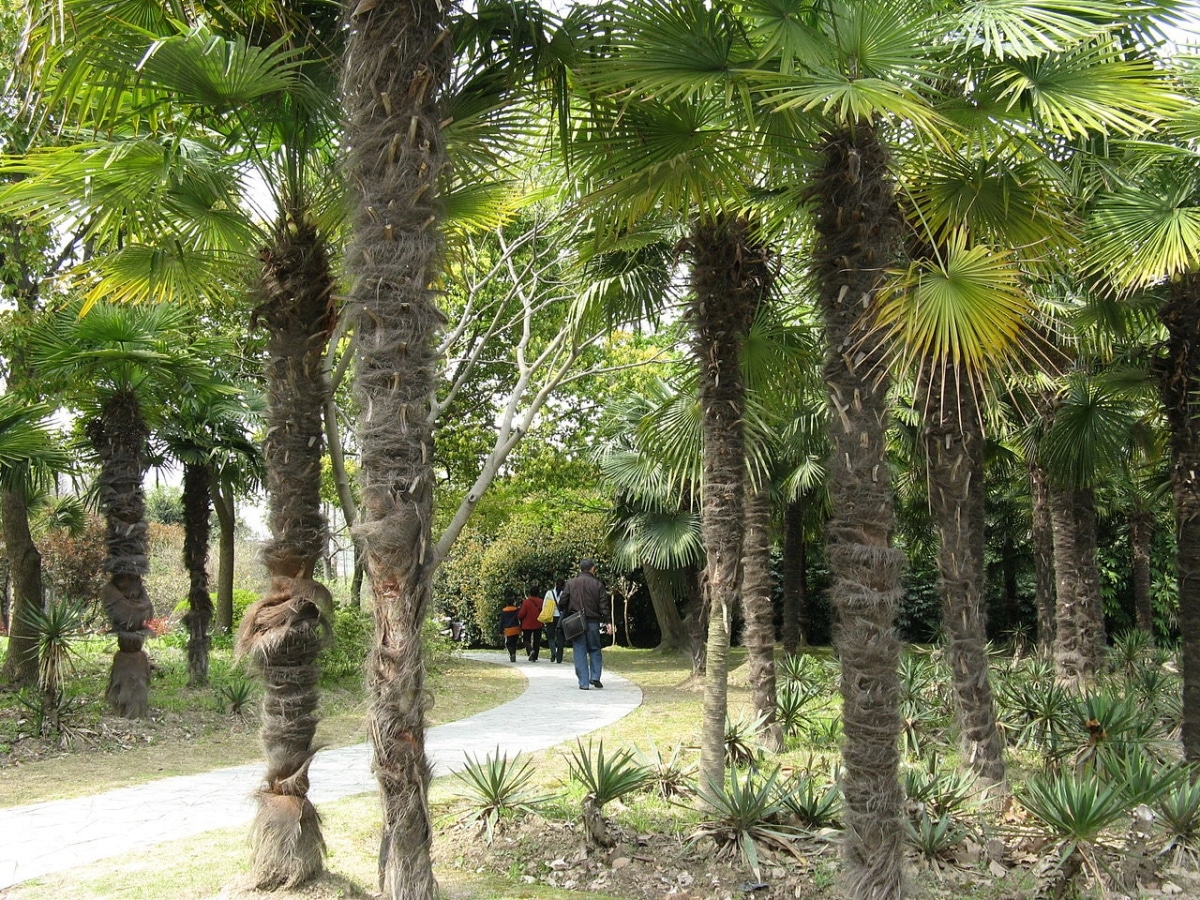
Image – Wikimedia/Vera Buhl
El Trachycarpus fortunei It is one of the species of palm trees that is most resistant to cold, and which also supports heat well., which is why it is grown both in tropical and subtropical gardens, as well as in temperate ones. Although its growth rate is slower than that of the Chamaerops humilis, a palm tree that looks a lot like our protagonist when the stems are removed, keeping it with only one, is much more rustic.
So, without a doubt, it is a plant of great interest to grow in areas where, for example, temperatures drop below zero degrees, and/or in those where there is little space. But, What are the care of the Trachycarpus fortunei?
Pot or soil?

Image - Wikimedia / Manfred Werner - Tsui
El Trachycarpus fortunei, known as elevated palmetto, is a palm tree with a single stem (or false trunk) that is usually covered with fibers (I say "usually" because in warm regions it is not uncommon to find specimens without them as gardeners take them off). These fibers help protect you from the cold and frost, so if temperatures drop below zero degrees in your area, you should not take them off.
In addition, we speak of a plant it doesn't take up much space, since although it can measure 10 or 12 meters in height, its stem or false trunk is relatively thin: it can measure about 30 to 40 centimeters thick. For all these reasons, we can ask ourselves if it is possible or not to keep it in a pot throughout its life, or if it is preferable that it be planted in the ground. And the answer is that this will depend more on us than on the plant itself.
And it is that the raised palm it adapts very well to living in the garden, but also in a pot. What happens is that, if we choose to have it in a container, we have to plant it in a larger one every few years, 3 or 4, otherwise it would stop growing and weaken. When our specimen is more or less 1 or 2 meters tall, we can plant it in the final pot, which should measure about 80cm in diameter (better if they are 100cm) for more or less the same height. As a substrate, we will put a specific one for green plants that you can buy here.
Sun or shade?
The elevated palmetto is a palm tree that we have to put in a place exposed to the sun. It is very, very important that it is not in the shade if we want it to grow well, with strength and health. The leaves need to be exposed to the light of the king star directly to carry out their vital functions, such as respiration or photosynthesis, normally.
For this reason, it is not a very good idea to have it inside the house, because in these conditions you do not always have all the light you need and, therefore, it is when your health can weaken. Also, keep in mind that it resists frost well, so it is not necessary to grow it indoors.
When should it be watered?

Image – Wikimedia/Emcc83
Although it withstands frost and snow very well, it does not like drought too much. That's why, we have to water our Trachycarpus fortunei several times a week throughout the summer so you don't get dehydrated. And the rest of the year, since the soil remains moist for longer, we will do it once a week, or twice if the soil feels dry.
We will use rainwater whenever possible, otherwise bottled or tap water suitable for consumption will be used. Of course, if we have it in a pot, it is important that we do not put a plate under it, because if we do, the water that does not filter will remain stagnant in the plate, and if we do not remove it, the roots would drown.
Do you have to pay the Trachycarpus fortunei?
One of the care that we must provide to the Trachycarpus fortunei is the subscriber. East will be done during the spring and summer, whether it is in a pot or planted in the garden. For this, we will use manures or fertilizers that are specific for palm trees such as this, and following the directions for use to avoid the risk of overdose.
In this way we will ensure that it grows at a good pace, and that it remains beautiful.
What pests can it have?

Image - Flickr / Katja Schulz
It is very resistant, but unfortunately it is one of the potential victims of two pests that, if not dealt with in time, can end its life in a few weeks: the Red weevil and paysandisia. Both in their adult state are not dangerous, but when they are larvae they cause very serious damage to palm trees, such as: galleries in the false trunk, leaves that open with holes, leaf fall, deviation of the central leaf, even you can make it flower early for a chance to set seed.
To avoid this, I recommend doing the following:
- Do not prune palm trees, ever. And if necessary, only remove leaves that are completely dry in autumn, when the weather starts to cool down. If you do it in spring-summer, there is a risk that these pests will damage our plant, since the smell of pruning wounds attracts them.
- When they are young, pour water over them at sunset, when the sun no longer gives them once a week. Thus, if they have larvae, they will drown.
- Carry out preventive treatments in spring and summer with insecticides that eliminate Red weevil and paysandisia, such as chlorpyrifos and imidicaloprid.
What is its resistance to cold?
The raised heart of palm is very resistant to frost and snowfall. Withstands temperatures of up to 15ºC degrees below zero (-15ºC) as long as they are short-term frosts. Now, with such low values, we can expect it to lose some or most of its leaves, but it will recover in spring. If we don't want that to happen to it, we can cover its crown of leaves with an anti-frost fabric that you can get here.
Do you have some Trachycarpus fortunei? We hope that now you can make it more beautiful.